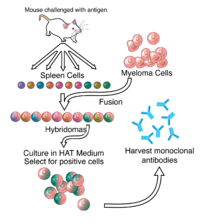
Photo from wikipedia
COVID-19 is a life-threatening respiratory disease triggered by severe acute respiratory syndrome coronavirus 2 (SARS-CoV-2). It has been considered a pandemic viral infection since December 2019. The investigation of the… Click to show full abstract
COVID-19 is a life-threatening respiratory disease triggered by severe acute respiratory syndrome coronavirus 2 (SARS-CoV-2). It has been considered a pandemic viral infection since December 2019. The investigation of the effective prophylaxis or therapeutic strategies for emergency management of the current condition has become a priority for medical research centers and pharmaceutical companies. This article provides a comprehensive review of antibody therapy and its different categories with their advantages and disadvantages for COVID-19 over the last few years of the current pandemic. Antibodies can be generated by active immunization, including natural infection with a pathogen and vaccination, or by the passive immunization method such as convalescent plasma therapy (CPT) and antibody synthesis in laboratories. Each of these ways has its characteristics. Arming the immune system with antibodies is the main aim of antiviral therapeutic procedures toward SARS-CoV-2. Collecting and discussing various aspects of available data in this field can give researchers a better perspective for the production of antibody-based products or selection of the most appropriate approach of antibody therapies to improve different cases of COVID-19. Moreover, it can help them control similar viral pandemics that may happen in the future appropriately.
Journal Title: Viral immunology
Year Published: 2022
Link to full text (if available)
Share on Social Media: Sign Up to like & get
recommendations!